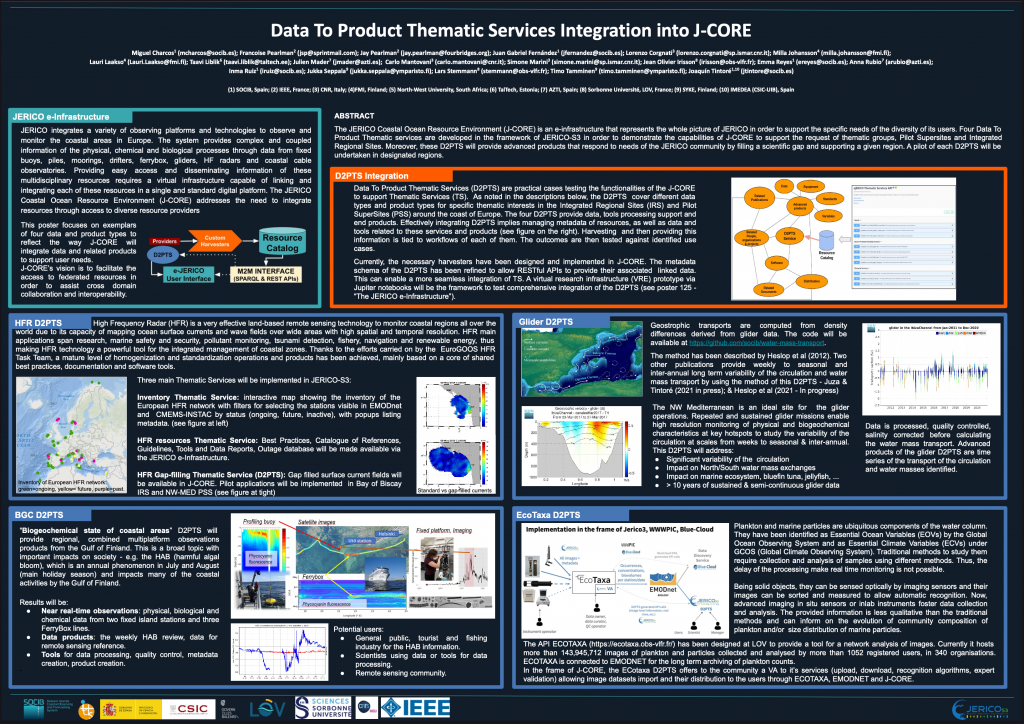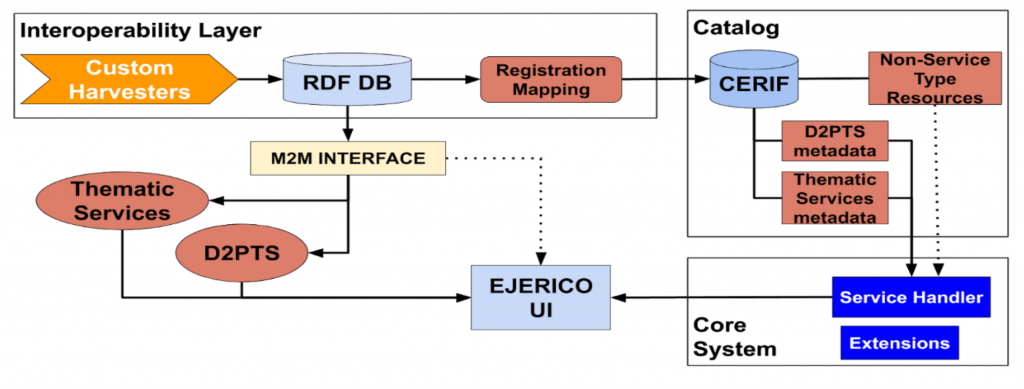Miguel Charcos, SOCIB (Spain) presents a poster on “Data to Product Thematic Services Integration into J-CORE” at the International Conference on Marine Data and Information Systems (IMDIS) 12-14th April 2021 virtual conference.

Introduction
The Joint European Research Infrastructure network for Coastal Observatory (JERICO) is a Pan European coastal marine observatory network that integrates a large diversity of resources including data from multiple types of observatories. This diversity of data and platforms offers an assortment of assets to support the creation of high-quality and diverse data products. In the new phase of the project, namely JERICO-S3, the implementation of a virtual infrastructure (called e-JERICO) will allow access to the information from assets, including data, that are distributed among all internal and external stakeholders. It will also provide a full range of access to documents, tools, software, and ocean best practices (OBPs). JERICO-S3 aims, among other objectives, to demonstrate the benefits of an e-Infrastructure for JERICO (e-JERICO) by designing and implementing the first elements of this virtual environment. Data To Product Thematic Services (D2PTS) are practical cases that respond to specific needs of the coastal community despite a diversity of data and platforms by providing added value products of different kinds. Four D2PTS will support the pilot phase and provide these capabilities of e-JERICO during the operation phase. They will provide advanced products, software capabilities, and services, for specific thematic interests in the Integrated Regional Sites (IRS) and Pilot SuperSites (PSS) around the coast of Europe.
The HF-Radar (HFR) D2PTS will provide physical oceanography products to fill the gap in water surface current data products addressing the need for a comprehensive understanding of ocean surface flows. It offers advanced analysis software and services for HFR. A pilot application will be undertaken in Iberian Peninsula IRS and NW-Mediterranean PSS. The glider D2PTS will contribute with estimations types and transport monitoring of seawater masses by combining Biogeochemical (BGC) and physical parameters. These advanced products will fill a gap in physical ocean transport analysis. A pilot application will be undertaken in the Gulf of Finland (GoF) and NW-Mediterranean PSSs. The BGC D2PTS will provide advanced data products (e.g.. HAB situation and remote sensing “sea-truth”) based on combined multiplatform NRT data, demonstrating the capabilities of coordinated transnational observations. It will respond to the needs of the integration of multiplatform observations. A pilot application will be undertaken in the GoF PSS. The JERICO-EcoTaxa D2PTS will provide new insights in the biological field by facilitating the study of coastal plankton monitoring products from optical and imaging sensors. It responds to a need to bring together the biological community to a joint effort of analysing biological images. A pilot application will be undertaken in NW-MED, Gulf of Finland, Channel and NorthSea PSSs.
D2PTS Integration
From a general perspective, e-JERICO (see Figure 1) harvests and connects information of different assets (i.e. data, documents, tools, software, etc) in a knowledge-based catalog of interconnected resources from distributed infrastructures such as data aggregators (EMODnet, SeaDatanet, CMEMS), Sensor Observation Services (SOS), documentation repositories (OBPS, OceanDocs) and software repositories. Thematic services will be integrated into e-JERICO in different ways depending on their level of maturity. The D2PTS represents various scenarios of integration that will demonstrate the entire range of capabilities of the e-JERICO infrastructure.

The integration of services provides the D2PTS users the opportunity to take advantage of the information of the JERICO community that is represented in the resource catalog. In a basic scenario, users will be able to access all the information to run the D2PTS including the necessary support such as manuals, best practices and portal information. A more advanced level of integration will allow thematic services to make use of the information of the resource catalog to support the service. For example, the BGC D2PTS can collect the list of platforms of the region to improve collaboration and the search of multiplatform data. Integration of a service could even allow seamless and remote execution of processing components alone or workflows of concatenated services. In this poster, we will examine the way these diverse resources are handled in e-JERICO for the four D2PTS.
